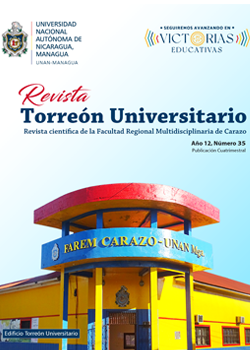Caracterización epidemiológica de estudiantes de enfermería y el consumo de anime y manga, POLISAL UNAN MANAGUA. Nicaragua. Primer semestre 2019
DOI:
https://doi.org/10.5377/rtu.v12i35.17000Palabras clave:
Síndrome Hikikomori, Estudiantes universitarios, Consumo de anime, Salud mentalResumen
Objetivo. Caracterizar epidemiológicamente la población de estudiantes de enfermería ante el consumo de anime, manga y dorama, POLISAL UNAN Managua. Nicaragua, primer semestre 2019. Diseño Metodológico: Con 249 estudiantes de enfermería que participaron en el estudio con una ruta de investigación descriptiva y de corte transversal, se utilizó un instrumento que contenía variables en estudio como: sociodemográficas, de consumo, riesgo de Hikikomori, la recolección de datos, llenado, tabulación, análisis y discusión fueron realizados en el mes de noviembre del 2019. Resultados: la edad que predominó fue entre los 18 y 25 años de edad en el perfil de enfermería obstetricia y perinatología con 97 (38.96%) estudiantes procedentes de la ciudad de Managua, de los cuales 83 (44.3%) son femeninos y 17 (35.42%) masculinos, 99 (39.76%) consumen anime, manga o dorama siendo los mayores consumidores los de enfermería obstétrica y perinatología y de estos el 57 (49.91%) lo hacen mediante internet con 54 (54.5%), dedicando de 1 a 2 horas en horarios de 7 a 12 media noche (mn) con 26 (26%). Tanto en género demográfico como temático no conocen la clasificación y de la población total del estudio 141 (57%) y corren el riesgo de desarrollar síndrome Hikikomori. Conclusiones: La población en estudio estuvo entre los 18 y 25 años predominando la mención de obstetricia y perinatología. Esta población provenía principalmente de Managua y Masaya y menos de la mitad de la población consume anime mediante internet principalmente, prefiriendo las series animadas en horarios nocturnos, de todos los participantes más de la mitad tiene umbral para categorizarse como en riesgo del síndrome de Hikikomori.
Descargas
214
VISOR 0
HTML 0
PDF (English) 41
HTML (English) 19
Citas
Benach, J., & Montaner, C. (2005). Aprender a mirar la salud: cómo la desigualdad social daña nuestra salud. Editorial El Viejo Topo.
Cobos, T.L. (2010). Animación japonesa y globalización: la latinización y la subcultura Otaku en América Latina, en Revista Razón y Palabra, No. 72, México, D.F., Tecnológico de Monterrey.http://www.razonypalabra.org.mx/N/ N72/Varia_72/32_Cobos_72.pdf.
Chen, Y. (2002). Personalization and the Problem of Youth in Japan. Sociological Research, (2), 6. https://www.scielosp.org/article/rbepid/2005.v8n1/7-17/
Foerster. (2009). Tesis para optar al título de antropólogo. Otakus en Chila. Facultad de Ciencias Sociales. Chile.
George A. Kaplan, (July, 2004). What’s Wrong with Social Epidemiology, and How Can We Make It Better?, Epidemiologic Reviews, Volume 26, Issue 1, Pages 124–135,https://doi.org/10.1093/epirev/mxh010
Hornos, A. (2013). Animación japonesa, Análisis de serie animadas actuales. Tesis Doctoral. Universidad de Granada. ISBN: 9788490830222. Pag. 44
Ito, M. (2012). Fandom Unbound: Otaku Culture in a Connected World. Yale University Press.
Kato, T. A., Kanba, S., & Teo, A. R. (2018). Hikikomori: experience in Japan and international relevance. World psychiatry: official journal of the World Psychiatric Association (WPA), 17(1), 105–106. doi:10.1002/wps.20497
Krieger, N. (2002). Glosario de epidemiología social. Revista Panamericana de Salud Pública, 11, 480-490. Segura del Pozo, Javier. (2006). Epidemiología de campo y epidemiología social. Gaceta Sanitaria, 20(2), 153-158. http://scielo.isciii.es/scielo.php?script=sci_arttext&pid=S0213-91112006000200011&lng=es&tlng=es.
Moreno-Altamirano, A., López-Moreno, S., & Corcho-Berdugo, A. (2000). Principales medidas en epidemiología. salud pública de méxico, 42, 337-348.
Muñoz, G. (2011). Jóvenes, culturas y poderes. Colombia: Siglo del Hombre Editores
Otaku, (2010). Otaku Sekai. http://otakusekainolima.blogspot.com.co
Paolicchi, L. (2011). ACTUAR Y HABLAR APUNTES PRELIMINARES PARA UNA TEORÍA PRAGMÁTICO TRASCENDENTAL DE LA ACCIÓN. Praxis Filosófica, (32), 57-72.
Pérez, E. (2013). La Cultura Otaku Estilo de Vida. https://releeportare.wordpress.com/2013/05/29/la-cultura-otaku-un-estilo-de vida/
Stip, E., Thibault, A., Beauchamp-Chatel, A., & Kisely, S. (2016). Internet Addiction, Hikikomori Syndrome, and the Prodromal Phase of Psychosis. Frontiers in psychiatry, 7, 6. doi:10.3389/fpsyt.2016.00006
Tateno, M., Park, T. W., Kato, T. A., Umene-Nakano, W., & Saito, T. (2012). Hikikomori as a possible clinical term in psychiatry: a questionnaire survey. BMC psychiatry, 12, 169. doi:10.1186/1471-244X-12-169
Teo, A. R., & Gaw, A. C. (2010). Hikikomori, a Japanese culture-bound syndrome of social withdrawal?: A proposal for DSM-5. The Journal of nervous and mental disease, 198(6), 444–449. doi:10.1097/NMD.0b013e3181e086b1
Teo AR, Chen JI, Kubo H, Katsuki R, Sato-Kasai M, Shimokawa N, Hayakawa K, Umene-Nakano W, Aikens JE, Kanba S, Kato TA. Development and validation of the 25-item Hikikomori Questionnaire (HQ-25). Psychiatry Clin Neurosci. 2018 Oct;72(10):780-788. doi: 10.1111/pcn.12691. Epub 2018 Jul 27. PubMed PMID: 29926525; PubMed Central PMCID: PMC6221010.
Teo, AR, y Gaw, AC (2010). ¿Hikikomori, un síndrome de retiro social vinculado a la cultura japonesa ?: Una propuesta para el DSM-5. El Diario de la enfermedad nerviosa y mental , 198 (6), 444-449. doi: 10.1097 / NMD.0b013e3181e086b1.
Descargas
Publicado
Cómo citar
Número
Sección
Licencia
Derechos de autor 2023 Universidad Nacional Autónoma de Nicaragua, Managua

Esta obra está bajo una licencia internacional Creative Commons Atribución-NoComercial-SinDerivadas 4.0.
Los autores que publican en esta revista están de acuerdo con los siguientes términos.
- El autor o los autores de los artículos, ensayos o investigaciones conceden a la Universidad Nacional Autónoma de Nicaragua, Managua (UNAN-Managua) los derechos de edición (copyright) del trabajo enviado, por consiguiente la Universidad cuenta con el derecho exclusivo para publicar el artículo durante el periodo completo de los derechos de autor.
- Estos derechos de autor/ autores autorizan a la Revista Torreón Universitario y a la Universidad editar y divulgar/publicar el artículo en dicha Revista, incluyendo reproducción impresa y electrónica, el almacenamiento, recuperación y cualquier otro tipo de publicación, y fuentes de información secundaria como servicios de resúmenes y bases de datos, así mismo la facultan a proteger el artículo contra el uso no autorizado para su difusión por medios impresos o electrónicos (PDF, HTML, EPUB, XML u otros).
Licencia para el uso del contenido
La revista hace uso de la Licencia Creative Commons Atribución-NoComercial-SinDerivar 4.0 Internacional.
Bajo esta declaración:

Este revista está sujeta a una licencia de Creative Commons Reconocimiento-NoComercial-SinObraDerivada 4.0 Internacional. Puede ser copiada, distribuida y transmitida públicamente siempre y cuando se cite al autor y la fuente (Revista Torreón Universitario), no debe modificarse ni utilizarse con ningún fin comercial. La licencia completa se puede consultar en http://creativecommons.org/licenses/by-nc-nd/4.0/.



